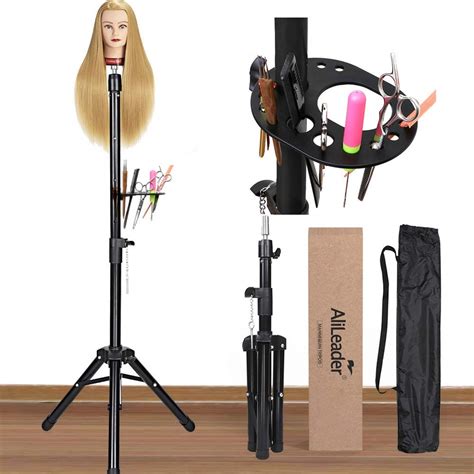Introduction
Whether you’re a seasoned hair aficionado or just starting to explore the world of wigs, a wig head and stand are indispensable tools that can elevate your styling experience. These versatile accessories provide a stable and convenient platform for wig styling, hairdressing, and display. In this comprehensive guide, we’ll delve into the world of wig heads and stands, exploring their benefits, uses, and best practices to help you maximize their potential.

Benefits of a Wig Head and Stand
1. Enhanced Styling Precision
A wig head and stand offer a secure and stable base for wig styling, allowing you to create precise cuts, curls, and styles with ease. The stationary head eliminates movement, ensuring that your creations remain in place throughout the styling process.
2. Damage Prevention
High-quality wig heads mimic the contours of a human head, preventing damage to delicate strands and reducing friction during styling. This is especially beneficial for wigs made from natural hair or heat-resistant synthetic fibers.
3. Easy Wig Customization
The flexibility of wig heads and stands allows you to adjust the head’s position, tilt, and angle, providing the perfect viewing and styling positions for customizing wigs. Whether you’re trimming bangs or adding hair extensions, a wig head and stand are indispensable tools.
4. Versatile Display Options
Wig heads and stands not only serve as styling platforms but also as excellent display solutions. They allow you to showcase your wig collection, wigs for sale, or custom creations in a professional and organized manner.
Considerations for Choosing a Wig Head
1. Size and Shape
Wig heads come in various sizes and shapes, from small to extra-large and from oval to round. Choose a head that best matches your head size and shape to ensure a snug fit for your wigs.
2. Material
The material of the wig head also plays a crucial role. Canvas or polystyrene heads are lightweight and affordable but may not provide the same level of realism as silicone or professional-grade foam heads.
3. Features
Some wig heads feature additional features such as adjustable necks, T-pins, or eyeholes. Consider the functions you need for your specific styling applications when selecting a wig head.
Types of Wig Stands
1. Clamping Stands
Clamping stands are versatile and adjustable, making them suitable for various wig sizes. They feature an adjustable clamp that secures the wig head in place.
2. Tripod Stands
Tripod stands are lightweight and portable, making them ideal for traveling stylists. They feature three adjustable legs that provide stability and can be folded for easy storage.
3. Mannequin Stands
Mannequin stands are designed to display wigs in a realistic and lifelike manner. They typically feature a mannequin head with shoulders, making them excellent for showcasing wigs in a retail or salon setting.
Common Mistakes to Avoid
1. Using a Wig Head without a Stand
Styling a wig on a wig head without a stand can lead to instability and potential damage to the wig. Always ensure that your wig head is securely attached to a stand before attempting any styling.
2. Overtightening the Clamp
When securing a wig head to a clamping stand, avoid overtightening the clamp. Excessive force can damage both the wig head and the stand.
3. Placing the Wig Head in Direct Sunlight
Exposure to excessive heat or sunlight can damage the wig. Store your wig head and stand in a cool, dry place when not in use.
Standards and Regulations
The wig head and stand industry is not subject to specific regulations. However, it’s crucial to purchase products from reputable manufacturers who adhere to industry standards.
Table 1: Comparison of Wig Head Materials
| Material | Pros | Cons |
|---|---|---|
| Canvas | Lightweight, affordable | Not as durable, less realistic |
| Polystyrene | Lightweight, inexpensive | Not as sturdy, can be easily damaged |
| Silicone | Realistic, durable | Expensive |
| Professional-grade foam | Highly realistic, durable | Pricey |
Table 2: Types of Wig Stands
| Type | Features | Uses |
|---|---|---|
| Clamping Stands | Adjustable, versatile | Wig styling, hairdressing, storage |
| Tripod Stands | Lightweight, portable | Travel, temporary displays |
| Mannequin Stands | Lifelike, display-oriented | Retail, salon displays, photography |
Table 3: Benefits of Using a Wig Head and Stand
| Benefit | Description |
|---|---|
| Enhanced Styling Precision | Stable and secure base for precise styling |
| Damage Prevention | Mimics human head contours, reducing friction |
| Easy Wig Customization | Adjustable positions for styling and customizing wigs |
| Versatile Display Options | Professional display solutions for wigs and hairpieces |
Table 4: Common Mistakes to Avoid When Using a Wig Head and Stand
| Mistake | Description |
|---|---|
| Using a Wig Head without a Stand | Instability and potential damage to the wig |
| Overtightening the Clamp | Risk of damaging the wig head and stand |
| Placing the Wig Head in Direct Sunlight | Exposure to heat and sunlight can damage the wig |
Innovative Applications: “Wigification”
“Wigification” refers to the creative use of wig heads and stands beyond traditional hair styling. By experimenting with different materials, techniques, and accessories, you can leverage these tools to create unique art forms, fashion accessories, and even home décor.
Conclusion
Wig heads and stands are essential tools that empower hair stylists, wig enthusiasts, and creatives alike. By choosing the right wig head and stand for your specific needs, you can elevate your wig styling experience, protect your wigs from damage, and display your creations with confidence. We encourage you to explore the possibilities offered by these versatile accessories and unleash your creativity to unlock a world of hair and styling potential.
